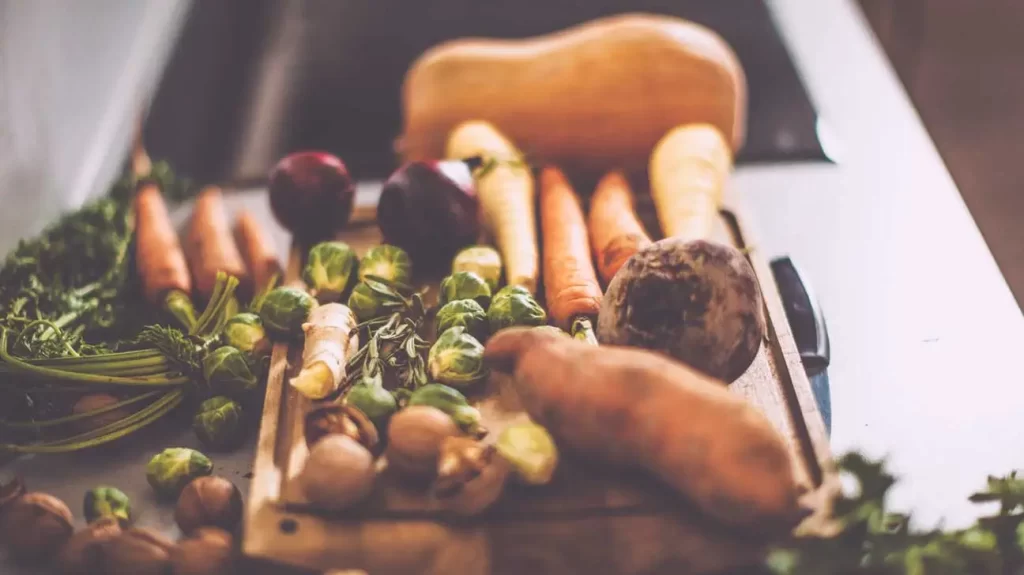
Vegetarianism as a day marked off every week had crept into their nuclear household at least a decade after Sneha and her parents had broken away from the joint family house that bore the family house deity (gruhadevta) and family house rules. By the time Sneha returned after having spent two and a half years in the States, her parents had enforced eating vegetarian food two days a week instead of one. Apart from Saturdays, Tuesdays had now been added to the veg or niramish days. Barring the newly constructed dread of the wrath of Hanuman, the weekly patterned mandate sometimes found justification in health benefits, while at other times it followed seasonal prescriptions found in the almanac. Saturdays were practised at her maternal grandmother’s house and many Bengali households in the city she grew up in. Yet the fervour to subscribe to a new pattern of proscriptions was unsettling. In the new regime, things had gotten stricter than she could last remember. In a strip search of polluting agents in food, all allium was discriminated against, gachh pnatha or tree mutton, as unripe jackfruits were well-known in and to her tongue, was cooked nothing like pnatha and the protein-rich musoor dal was banned from among the sisterhood of cooler lentils.
Sneha believed in her own head and maintained in her own circles that she was free from the label dreaded ‘bh-’ label but could easily masquerade as a level 2 devout on cue, to avoid suspicion. Even though it often meant treating herself as a germ. This entailed pretending to subscribe to various mandates around the household that involved avoiding multiple preposterous postures of pollution. Some applied to others too—do not eat on the bed, do not touch things while eating, do not store leftovers from a plate, do not eat food off someone else’s plate, etc etc. Others were hers alone—do not do anything for 5 days a month (except climb trees and play football as they show in the ads perhaps). Quite like the sacred grains of rice or onno that became polluting entho when cooked and cultured into bhaat, she became aware of her many polluting potentials when she was past the thresholds of girlhood, kicked and cooked into womanhood.
Tuesdays were added a week after the grand inauguration. That was a couple of weeks after the pamphlets reached home. Along with a tiny paper pouch of something granular that sounded like a familiar toy from childhood when shaken. One bore an “artist’s image” of the temple, and the other, a long instruction manual on how to be the best version of neo-Hindu on January 22nd. A deity was being born. A bulleted list in Hindi and English. Sneha took a long look at the image, trying to familiarise herself with the contours of the imagined architecture, lest she failed to acknowledge it with sufficient religious fervour later the streets in the passing and infuriated mobs ahead of her in the syllabus, well-versed in the chants, the rituals, and the fury. All artists across all regions, working on these little pamphlets of loyalty have been taught to imagine the same mandir, she thought –sandalwood tinted, a juxtaposition of multiple architectural styles, erected upon unnaturally green grass against unusually blue skies. And they did so with remarkable editorial skills, erasing away the greyish-brown pollution from the skies like it never existed.
She thought about the people who would drink up this image and set on an expensive pilgrimage expecting the same HD clarity in person. She wondered if the smog would make their devotion hazy and if they would be disappointed like people plan to be in front of the Eiffel and buy miniature souvenirs afterwards. Or perhaps devotion will prevent them after all, in a way that is relatively unknown among pilgrims in Paris.
She thought about the only Ram she knew from a dilapidated copy of Krittibas Ojha’s Bengali Ramayana that she used to carry to school in class V for our vernacular classes—an embarrassingly old brown and crumbly paperback that belonged to her mother when she was in school. That Ram was less of a war hero in history and more of a wronged character in mythology. And there was room for Sita’s plight and the rookie mistake that Lakshman made; the symbolism of Surpanakha and the brilliance of Ravan’s villainy.
She had tried to conjure an image of Ram lalla. She had failed. She had asked around to make sure she understood the meaning of ‘lalla‘ correctly and drawn up two possible versions of a baby god. One had borne striking resemblances with ‘Baal Gopal’, another popular baby god icon she had been encultured to recognise. For the second, unlike Gopal—who in most cases has been destined to sit uncomfortably and infinitely on one hand and hunches— she had kept him standing like Ram is condemned to do in every illustration she had seen of him thus far. Weapons seemed unrealistic for an infant, so she had stripped those away. Then she had Googled and found leaked images of the unborn idol. Something felt sinister about looking on, but she had taken in the details, nonetheless. The dark metal figurine had seemed smaller than it ought to have been and had weapons after all—the signature bow and arrow and a pair of uncomfortably set eyes.
She had thought about the proliferation of the mandir. How it had spilled onto the streets and filled every nook and cranny of the public. Sometimes by government mandate and at others with roaring public enthusiasm. “The public has been mobilised well enough to operate as a quasi-state,” she had thought to herself. “Only this diffused state is more violent than a state could/ should be… And the worst part is that the state would carry no burden of said violence.” The rejoicing of some and terror of others work in unison, in ominously proportionate measure—a certain brand of unity in diversity. The idol was never the point—the mandir is the point. With its gigantic sprawl of several converging styles of temple architecture, claiming space is the point. Darshan isn’t seeing god and being seen by god, but it is about seeing the mandir built upon a very specific piece of land.
The little sachet of shakers turned out to be soil. Iconic soil from the holy land— make-believe, like the moist soil from flowerpots Sneha would carry in her palms as a child during a serious game of khelna baati and pretend it was make-believe dough for make-believe rotis. Only this time it was carefully kept out of her touch. And this time the soil and its surrounding play lasted much longer than playtime. The place was made for it on the little altar that their tiny apartment could accommodate and soon developed new rituals of praying with new sounds of mantras. Baapi brought home a little booklet of the Hanumaan chalisa and Ma tried to memorize the religious rhyme religiously every day, growing louder and more engrossed on Tuesdays. Sneha would try to memorize it with her to give her company. Being a more comfortable speaker of Hindi than Ma was, the words seemed to sit easy on her tongue and get off easier too. Soon she grew over it. Yet Ma kept trying to train her tongue—almost as much as she trained her tongue through various observances of fasts and diets to hold off family’s omongol or evil. Diets that seldom affected Sneha or her Baapi except being meant for their well-being. Thus niramish on Tuesdays introduced Hanuman as a deity out of mythology’s nowhere into the everyday of the family. And in no time, the entire house turned into an extension of the altar. In no time through a leafy green diet, saffron digested the minds of the people. In no time, the mandir entered through the kitchen.
***
Mahashewta Bhattacharya is a third-year PhD candidate in Anthropology at the University of British Columbia, Vancouver. Her research deals with placemaking through homemaking among rural to urban migrant women in India.

Very well written!